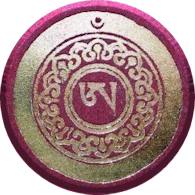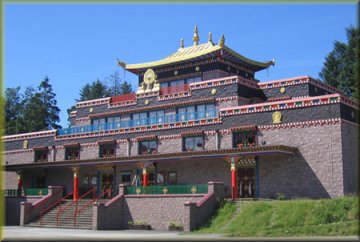
Akong Rinpoché Establishing Buddha-Dharma
Part Seven: The Samye Temple Opening
 1988 was a key moment in Rinpoché’s life, crowning many of his achievements and also becoming something of a watershed in his personal story and that of Samye Ling. It was the year in which the temple was completed and opened and also the year in which the first long retreat ended. Rinpoché himself listed seven main “fruitions” occurring in that year.
1988 was a key moment in Rinpoché’s life, crowning many of his achievements and also becoming something of a watershed in his personal story and that of Samye Ling. It was the year in which the temple was completed and opened and also the year in which the first long retreat ended. Rinpoché himself listed seven main “fruitions” occurring in that year.
He wanted to find an auspicious date for the official opening of the temple, sometime in summer, and opted for 8.8.88 for the secular opening and celebrations, as the number eight is considered auspicious and balanced by Tibetans and Chinese, but also chose a day for the spiritual consecration, to be led by the Tai Situpa, based on Tibetan astrology.
Finishing the temple was a cliff-hanger, probably only made possible by Rinpoché’s constant presence and pressure. The temple roof was to be coated with a special, highly-resistant covering that gave it a golden hue. The last spraying of this was still happening by floodlight on the night before the opening ceremony. Rinpoché wanted the opening to be a signal event—a festival with artistic and other presentations lasting for some days. To this end, marquees were erected and various performers invited.
The consecration ceremonies could have been performed by no one better than the Tai Situpa: for Rinpoché, that was perfect. For the secular opening, he invited the then Sir David Steel, later to become Lord Steel of Aikwood and 1st Presiding Officer of the Scottish Parliament. The latter, a very well-known politican and public figure, had proved a good friend and advisor to Akong Rinpoché: they had met through the good auspices of Lord Tanlaw.
When it was announced that Sir David would co-open the temple, with the Tai Situpa, Rinpoché received complaints and even threats to sabotage the event, because Sir David had been the first person successful, after six previous attempts since World War Two, in introducing changes to the old abortion laws. He had done this because
“The case for reform was overwhelmingly supported by the various medical organisations and most of the mainstream Protestant churches. They were motivated as was I by revulsion at the damage caused by criminal and self-induced abortion and the hypocrisy of available subterfuge abortion on payment.”
Members of the “pro-life” movement at the time of the temple opening were the ones writing the bitter letters and sending photos of aborted foetuses to Rinpoché, who was truly distressed and unsure how to proceed. Once he understood the context that had driven Sir David to promote the bill, he decided to maintain the invitation. He continued to receive occasional criticism on this point for many years, partly caused through the plaque, commemorating the inauguration, mentioning Sir David’s name.
 Dignity and legality were issues very important for Akong Rinpoché, who wanted the best for Samye Ling and wanted it to be respected. He would say how necessary it was for that to happen in order for the Buddha’s teachings—especially those of Tibetan Buddhism—to become valued in the West. Samye Ling would be a vital indicator to people of what Tibetan Buddhism was: a sort of thermometer.
Dignity and legality were issues very important for Akong Rinpoché, who wanted the best for Samye Ling and wanted it to be respected. He would say how necessary it was for that to happen in order for the Buddha’s teachings—especially those of Tibetan Buddhism—to become valued in the West. Samye Ling would be a vital indicator to people of what Tibetan Buddhism was: a sort of thermometer.
In general, Rinpoché was delighted when well-known and respected figures made a public connection with Samye Ling and those who know the centre and its offices will have seen the photos of Akong Rinpoché or Lama Yeshe Rinpoché with members of the royal family and other dignitaries or stars.
That simple fact of exhibiting such photos has also drawn criticism from people who think that Buddhist teachers should hold everyone in equal value and that something was wrong there. They did not realise that these connections were valued and nurtured first and foremost in order to help give Buddhism a good and respected name. While on this note, it may also be helpful to mention something Rinpoché often stated, as one of his guidelines: “The Buddha’s teachings needs to harmonise with the laws and customs of the lands it reaches.” He truly believed this and that, even if eventually Buddhism was to bring about improvements and changes to the laws themselves, at first there must be respect for the existing ones. Many people coming to Samye Ling have been in favour of the legalisation of marijuana. Whatever Rinpoché’s own opinions on the subject, his first stance was that it should not be allowed in our centres and that it should be discouraged to our members, simply because of this question of legality and respecting the law.
To return, after these reflections, to the actual temple opening and well-known personalities, Rinpoché was particularly keen for leading members of other faiths in Britain to participate in the opening ceremony, which they did, as a gesture of present respect and future harmony and cooperation. He also, along with the Tai Situpa, organised a major inter-faith symposium for 1988, in which leading scholars of major faiths would discuss, mainly in private, one central issue. This took place very successfully and was followed by two more such symposia, each giving rise to a publication.
 The temple opening marked the beginning of a watershed. In order to complete the building in time and to furnish all its beautiful artwork, the Samye Ling community had swollen to over one hundred strong, having a considerable number of builders and craftspeople. The temple finished, many of these people needed to go away to work and restore their depleted funds. Others were to enter the second long retreat, soon to commence. Although the opening was followed by a relative pause in building activity and a need for considerable fund-raising before the next phase could be started, there were still other activities, such as a conference of Nobel Prize-winners and the Tai Situpa’s Pilgrimage for World Peace, not to mention the ongoing quest for the new Karmapa, keeping Rinpoché very busy. Nevertheless, this pet project, so close to his heart, of building the temple was over and he was freed from the responsibility of holding its reins.
The temple opening marked the beginning of a watershed. In order to complete the building in time and to furnish all its beautiful artwork, the Samye Ling community had swollen to over one hundred strong, having a considerable number of builders and craftspeople. The temple finished, many of these people needed to go away to work and restore their depleted funds. Others were to enter the second long retreat, soon to commence. Although the opening was followed by a relative pause in building activity and a need for considerable fund-raising before the next phase could be started, there were still other activities, such as a conference of Nobel Prize-winners and the Tai Situpa’s Pilgrimage for World Peace, not to mention the ongoing quest for the new Karmapa, keeping Rinpoché very busy. Nevertheless, this pet project, so close to his heart, of building the temple was over and he was freed from the responsibility of holding its reins.
In the couple of years that followed, Lama Yeshe Losal came more and more onto the Samye Ling landscape, as did the Holy Isle project with the decision to shift efforts into that and to put Phase Two of the Samye Project on hold. By 1992, Rinpoché’s activities in Tibet had increased significantly, partly due to his close role in finding the new Gyalwang Karmapa. In retrospect, the period 1988-1992 marked the transition between the first phase of Rinpoché’s time in the West, dominated by Samye Ling, and the second phase, dominated mainly by humanitarian aid but also a broader development of his activities, such as Tara and the dharma in Africa.
The building of the temple, the opening of the temple and all that has happened in it (and because of it) ever since, are all a tremendous credit to Chöjé Akong Rinpoché. It is said that the merit (punya) of building a temple endures until the very last stone is removed. Rinpoché certainly made a gigantic merit through the Samye Temple.
......continue to the next part of the story: The Samye Project
